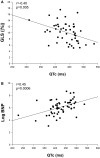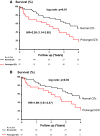Relationship Between QT Interval and Outcome in Low-Flow Low-Gradient Aortic Stenosis With Low Left Ventricular Ejection Fraction
- PMID: 27792655
- PMCID: PMC5121501
- DOI: 10.1161/JAHA.116.003980
Relationship Between QT Interval and Outcome in Low-Flow Low-Gradient Aortic Stenosis With Low Left Ventricular Ejection Fraction
Abstract
Background: QT interval has been shown to be associated with cardiovascular events. There is no data regarding the association between QT interval and left ventricular (LV) function and prognosis in patients with low LV ejection fraction (LVEF), low-flow, low-gradient aortic stenosis (LF-LG AS). We aimed to examine the relationship between corrected QT interval (QTc) and LV function and outcome in these patients.
Methods and results: Ninety-three patients (73±10 years; 74% men) with LF-LG AS (mean gradient <40 mm Hg and indexed aortic valve area ≤0.6 cm2/m2) and reduced LVEF (≤40%) were prospectively included in this analysis and 63 of them underwent aortic valve replacement within 3 months following inclusion. Prolonged QTc was defined as QTc >450 ms in men and >470 ms in women. LV global longitudinal strain was measured by speckle tracking and expressed in absolute value |%|. QTc correlated with the following: global longitudinal strain (r=-0.40, P=0.005), LVEF (r=-0.27, P=0.02), stroke volume (r=-0.35, P=0.007), and B-type natriuretic peptide (r=0.45, P=0.0006). During a median follow-up of 2.0 years, 49 patients died. Prolonged QTc was associated with a 2-fold increase in all-cause mortality (hazard ratio=2.05; P=0.01) and cardiovascular mortality (hazard ratio=1.89; P=0.04). In multivariable analysis adjusted for EuroSCORE, aortic valve replacement, previous myocardial infarction, LVEF, and ß-blocker medication, prolonged QTc was independently associated with all-cause mortality (hazard ratio=2.56; P=0.008) and cardiovascular mortality (hazard ratio=2.50; P=0.02).
Conclusions: In patients with LF-LG AS and reduced LVEF, longer QTc interval was associated with worse LV function and increased risk of death. Assessment of QTc may provide a simple and inexpensive tool to enhance risk stratification in LF-LG AS patients.
Clinical trial registration: URL: https://www.clinicaltrials.gov. Unique identifier: NCT 01835028.
Trial registration: ClinicalTrials.gov NCT01835028.
Keywords: B‐type natriuretic peptide; Doppler‐echocardiography; QT interval; aortic stenosis; left ventricular function; low‐flow low gradient; outcome; risk stratification.
© 2016 The Authors. Published on behalf of the American Heart Association, Inc., by Wiley Blackwell.
Figures


References
-
- Connolly HM, Oh JK, Schaff HV, Roger VL, Osborn SL, Hodge DO, Tajik AJ. Severe aortic stenosis with low transvalvular gradient and severe left ventricular dysfunction. Result of aortic valve replacement in 52 patients. Circulation. 2000;101:1940–1946. - PubMed
-
- Monin JL, Quere JP, Monchi M, Petit H, Baleynaud S, Chauvel C, Pop C, Ohlmann P, Lelguen C, Dehant P, Tribouilloy C, Gueret P. Low‐gradient aortic stenosis: operative risk stratification and predictors for long‐term outcome: a multicenter study using dobutamine stress hemodynamics. Circulation. 2003;108:319–324. - PubMed
-
- Quere JP, Monin JL, Levy F, Petit H, Baleynaud S, Chauvel C, Pop C, Ohlmann P, Lelguen C, Dehant P, Gueret P, Tribouilloy C. Influence of preoperative left ventricular contractile reserve on postoperative ejection fraction in low‐gradient aortic stenosis. Circulation. 2006;113:1738–1744. - PubMed
-
- Clavel MA, Fuchs C, Burwash IG, Mundigler G, Dumesnil JG, Baumgartner H, Bergler‐Klein J, Beanlands RS, Mathieu P, Magne J, Pibarot P. Predictors of outcomes in low‐flow, low‐gradient aortic stenosis: results of the multicenter TOPAS Study. Circulation. 2008;118:S234–S242. - PubMed
-
- Tribouilloy C, Levy F, Rusinaru D, Gueret P, Petit‐Eisenmann H, Baleynaud S, Jobic Y, Adams C, Lelong B, Pasquet A, Chauvel C, Metz D, Quere JP, Monin JL. Outcome after aortic valve replacement for low‐flow/low‐gradient aortic stenosis without contractile reserve on dobutamine stress echocardiography. J Am Coll Cardiol. 2009;53:1865–1873. - PubMed
Publication types
MeSH terms
Substances
Associated data
Grants and funding
LinkOut - more resources
Full Text Sources
Other Literature Sources
Medical
Research Materials

